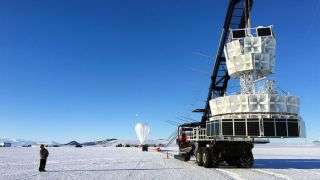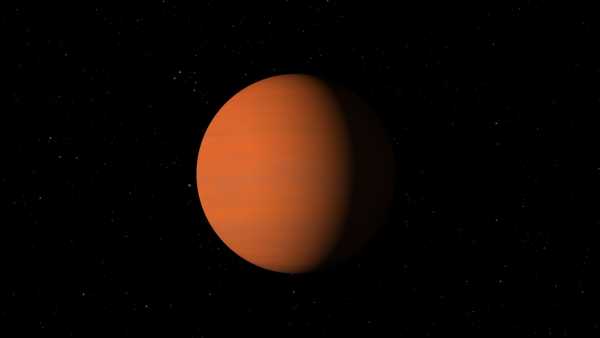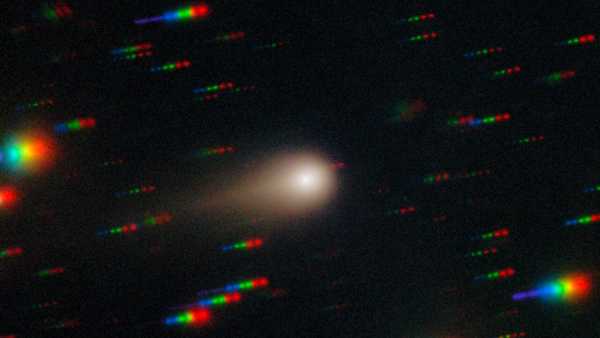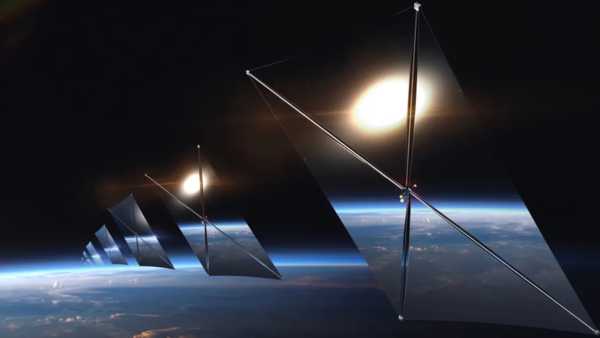
Researchers prepare to launch the Antarctic Impulsive Transient Antenna (ANITA) experiment, which picked up signals of impossible-seeming particles as it dangled from its balloon over Antarctica.
What if one of the strangest, most unsettling findings in particle physics turned out to be an illusion?
Since March 2016, two mysterious signals from Antarctica have baffled researchers. Twice now, a high-energy particle has seemed to burst straight up out of the ice, tripping detectors on a balloon-borne experiment floating overhead. It’s as if the particles had passed through the entire Earth unscathed. But that should be all but impossible: None of the known particles, which collectively are described in a physics model known as the Standard Model, can make that trip at high-energy levels.
Particles that are otherwise identical can carry different loads of energy, and the amount of energy a particle is carrying can change its behavior. Ghostly, low-energy neutrinos can slip through all of the planet’s crust, molten rock and iron unbothered. But they don’t pack enough punch to create the signals found in Antarctica. High-energy neutrinos are powerful enough to create the signals. But since these higher-energy neutrinos have larger “cross sections” — they impact a bigger region of surrounding space — they tend to bang into things rather than slip through them. It’s the difference between tossing a marble through a fishing net and trying to shoot a beach ball through the same gaps. No known high-energy neutrino should be able to pass through the entire Earth and emerge from Antarctic ice.
Physicists termed the two detections the “ANITA anomaly,” after NASA’s Antarctic Impulsive Transient Antenna (ANITA), the airborne detector that picked up the signals. They compared ANITA’s findings to results from IceCube — a much larger neutrino observatory in Antarctica — and found more support for the notion that they had found something no one had seen before. And they took seriously the idea that ANITA might have stumbled onto something beyond the Standard Model.
Now, in a new paper published April 24 in the journal Annals of Glaciology, a joint team of physicists and glaciologists argue that the ANITA anomaly likely isn’t evidence for new physics. Instead, it may simply be a trick of the ice. Complex, hidden structures in the white expanse might have reflected radio waves in unexpected ways, fooling ANITA’s radio receivers into registering the particle as if it were coming from inside Earth.
How the anomaly worked
ANITA was never meant to hunt new particles.
“It’s a really, really simple experiment in a sense,” said Ian Shoemaker, a physicist at Virginia Tech and lead author of the new paper. “All that they have basically is a big balloon, and attached to the bottom of it is a bunch of radio receivers. And all they’re detecting from any event is a radio signal.”
But radio signals can hold a lot of information about particles in the extreme high-energy range.
When ANITA was built, it was designed to hunt an exotic sort of event predicted by the Standard Model. High-energy tau neutrinos — one of three neutrino flavors along with electron and muon neutrinos — are among the most elusive particles in the Standard Model. These neutrinos should hit Earth pretty often from deep space. But they’re difficult to detect.
When tau neutrinos hit something and decay, they produce another type of particle called a tau. The hope was that in Antarctica, tau neutrinos would sometimes hit Earth at shallow enough angles that they would decay in the ice, producing a tau particle and a characteristic, detectable radio signal from the tau’s passage through the ice. That radio signal has a predictable waveform: a big spike, a big dip, a smaller spike and a smaller dip — a shape mostly determined by Earth’s magnetic field. And it would hit ANITA from below and to the side, evidence of the glancing angle with which it struck the planet.
ANITA has picked up on a handful of events like that, as well as signals from cosmic rays coming straight down at Antarctica from deep space. When that happens, an energized particle — perhaps a proton — hits the atmosphere over Antarctica, bursts into a shower of smaller charged particles, and produces a radio burst that reflects off the ice before hitting ANITA. Again, these events produce that same shape of wave as the tau neutrinos. The shape is largely determined by Earth’s magnetic field and carries only faint hints of the particles themselves, Shoemaker told Live Science.
But ANITA can tell a tau neutrino from a basic cosmic ray: When the radio waves strike the ice and bounce up at ANITA, their shapes flip. So instead of seeing UP-DOWN-up-down of a tau glancing through the ice, ANITA sees the reflected DOWN-UP-down-up of a cosmic ray. And these cosmic ray signals can hit ANITA from any direction as they bounce off the ice.
The two ANITA anomalies didn’t fit into either category. In each case, ANITA detected the un-mirrored waveform that would suggest a tau neutrino, UP-DOWN-up-down. But the wave struck ANITA at an angle so sharp that to have arrived without bouncing it would have had to pass through an impossibly thick chunk of Earth.
It was a signal that ANITA’s designers didn’t expect when they built the detector, and it hinted at the possibility of new, unknown particles bursting up from Antarctica.
Anomaly or illusion?
After years of study, physicists have been left with no easy explanation for the anomalies, said Derek Fox, a neutrino expert at Pennsylvania State University. Fox, a member of the IceCube collaboration, wasn’t involved with the ANITA experiment or the new paper.
Physicists had proposed some unusual explanations that wouldn’t break the Standard Model. A phenomenon known as “coherent transition radiation” might have messed with the radio waves coming from a cosmic-ray shower, two theorists suggested in March 2019. Or, maybe the signals came from dark matter effects in a mirror universe, a March 2018 paper proposed.
But barring these more mind-bending explanations, Fox told Live Science, “atmospheric or glacial anomalies are pretty much what you’re left with” before a new particle becomes the only explanation.
(It’s also possible that some instrumental problem with ANITA might have produced the signal he said, but that’s doubtful given how technically adept the ANITA team is.)
Still, Fox said, no one had yet offered a compelling explanation for how air or ice effects could produce the ANITA anomalies. That was before Shoemaker’s team came along, with its unusual combination of particle physicists, radio experts and glaciologists.
The authors of the new study made a straightforward argument: When radio waves passing through air bounce off of a dense object, like the top layer of ice, their waveforms flip in the way ANITA expects. But there are other sorts of reflections that could trick ANITA’s sensors.
When a wave passing through a high-density substance (like rock) hits a lower-density substance (like water), some of the wave’s energy will reflect back. But that reflection looks different from the one that occurs when a wave travels from a low-density environment (like air) to a high-density object (like ice).
As you travel down from the Antarctic sky toward the center of the Earth, like the shower of a cosmic ray, you’ll mostly encounter one denser environment after another. The air gets thicker and thicker. Then you hit ice. Then you hit rock. Then you end up in the planet’s hot, dense center. At each of those transitions, a bouncing wave would look just as ANITA expects.
But there are features in the ice that don’t fit that pattern, Shoemaker and his colleagues pointed out. Snow-covered crevasses, regions of stressed crystal known as “ice fabric layers” and lakes of liquid water buried beneath the frozen surface might all reflect a cosmic ray’s radio signal without mirroring it.
But subglacial lakes and snow-covered crevasses aren’t common enough to be likely explanations for the ANITA event, the researchers found. Ice fabrics, and another low-density ice feature known as “wind crusts,” might explain the anomalies, they said. But glaciologists don’t have a good handle on how common they are in the region. Two features, however, stand out as likely explanations, Shoemaker and his team wrote.
The first is firn, a type of frozen water that isn’t as soft and loose as fresh snow, but hasn’t yet been compressed into a single block of ice. Firn layers melt, move around and refreeze over and over, producing layers of high and low density. No one has looked for firn in the regions when ANITA spotted the anomalies, but it’s widespread in Antarctica and can reflect radio waves without mirroring them.
The other possibility is hoar. Layers of thick snow and ice will sometimes hide weaker, crumbly layers of ice that is lower density than the ice above it. Mountaineers know and fear this ice, according to Ulyana Horodyskyj, a glaciologist at Colorado College who wasn’t involved in ANITA or Shoemaker’s paper. When weak hoar layers slip on mountainsides, the ice overhead can collapse in a rush — an event known as an avalanche. Again, there’s not yet any direct evidence for this sort of double layer in the ANITA area. But hoar is widespread in Antarctica, and might explain an unusual reflection.
None of that is proof that the ANITA team mistook some weird ice for an up-going particle, the authors wrote. But it shows that ANITA alone probably can’t distinguish the two as well as physicists thought.
“Future experiments should not use phase inversion [the waveform’s switch from UP-DOWN-up-down to DOWN-UP-down-up] as a sole criterion to discriminate between down-going and up-going events, unless the subsurface reflection properties are well understood,” the authors wrote.
In other words, Antarctica is too complicated to treat as a simple mirror without careful study. The crystals buried below the surface can play tricks. And those tricks might explain the anomaly.
“Ice is ice — until it’s not, right?” Horodyskyj told Live Science.
Glaciologists use radio waves to study ice all the time, she said. Penetrating radar can reveal features that aren’t visible on the surface. But those signals are often messy and interpreting them can be more of an art than a science.
“You have all these different layers of densities that could throw the whole signal,” Horodyskyj said. “If you have metal, debris, rocks, water and ice, those are really easy to tell apart. They all have their own signal or fingerprint. But once you get into these details of ice, it’s really fascinating how even the softness of ice changes the signal.”
It’s not surprising, she said, that these subtle ice features might create an illusion of new physics.
Open questions
Physicists need to see more before they’re convinced one way or the other.
“It is a possible explanation,” said Peter Gorham, a physicist at the University of Hawaii at Mānoa and leader of the ANITA collaboration, “but in my opinion quite unlikely.”
The most baffling implication of Shoemaker’s paper, Fox said, is that whatever ice feature may have created the anomaly reflected the signal perfectly.
Under normal circumstances, a wave bouncing off something doesn’t bounce cleanly — whether it’s mirrored or not. Different wavelengths usually get reflected in different ways, Fox said, leaving traces of what physicists call “processing.”
“The thing is, I looked at the wave myself,” Fox said, “and I didn’t see anything that looked to me like processing.”
If something did reflect the wave back up to ANITA, it did so without leaving any detectable traces.
“The signal is very clean, quite in line with other normal cosmic rays we have observed. There is no evidence in the data for any significant perturbations of the signal outside of a normal reflection,” Gorham told Live Science.
The Shoemaker paper offers an explanation for this; with the right density structure, a reflector might be uniform enough across different wavelengths to process a clean signal. It would be like having a super clean mirror.
In this clean mirror model, there would actually have been two radio bursts for each ANITA anomaly. One, the “primary” reflection, would have been flipped in the way ANITA expects. But if the surface were sloped properly, it would bounce away from ANITA’s sensors. Only the second burst, that clean, un-mirrored echo would have hit ANITA’s receivers.
“While possible, this seems to require a coincidence that is very difficult to assess: a subsurface layer of just the right properties, combined with a surface slope also with the right properties,” Gorham said.
Shoemaker said that when he began studying the ANITA anomaly, he was hoping to find evidence for new physics; he didn’t set out to debunk the finding.
At this point though, he said, “If someone were to ask me ‘Is this some sort of new sterile neutrino or axion or something [beyond Standard Model particles], or is it ice?’ I would have to say, ‘It’s ice.’ Firn density inversions are things we know exist, without requiring new physics. So if I had to place a bet that’s what I would put my money on.”
By rigorously showing how widespread these sorts of features are in the ANITA region, Shoemaker’s team made a strong case that some sort of unusual reflection might have caused the ANITA anomaly, Fox said. But it’s not yet a knockout punch for new physics. To confirm or disprove the Shoemaker paper, you’d need direct evidence for this sort of unusual reflection happening in Antarctica.
So far, Gorham said, the evidence is in favor of nothing strange in the ice.
“The ANITA group has made many studies of Antarctic ice, and has published several papers also in the glaciology literature, going back for a decade or more,” he said. “We have studied in detail via satellite altimetry and radar maps the locale of these events, and for this one in particular there appears to be nothing unusual.”
He added that the ANITA collaboration has preliminary results from an as yet-unpublished study that would seem to contradict what Shoemaker and his coauthors proposed.
The Shoemaker paper suggested sending a team to the sites of the anomalies and bouncing radio waves off the ice to see what would happen.
Horodyskyj agreed with that approach.
“What you need is ground truth,” she said.
This part of Antarctica is unusually desolate, even for that empty continent, she said. Looking through the glaciology literature, she said, she found little direct data on the makeup of the ice in the region where ANITA spotted the anomalies. Few ice cores or other on-the-ground studies offer a sufficiently clear picture of the subsurface ice.
“You would have to figure out: What’s the footprint of the experiment from the air that they did?” she said, referring to the area of ice that the up-going particle seemed to come from. “If it’s 100 by 100 meters, you’d want to do the exact same thing on the ground: 100 by 100 meters, gridded out, put markers and the corners, and then you would take out the radar.”
Carrying a radar slowly over the ground, she said, would offer enough detail to really understand the ice. Depending on the logistics, you could walk it over the landscape, ski or use a snowmobile.
Mapping out the area piece by piece could reveal the depth of firn-to-glacier transitions and other details that wouldn’t be detectable from afar, she said.
“Up in the area that they’re working, it’s pretty dry, so that firn level can extend really deep compared to parts along the coast where there’s a lot more melting,” she said. “And then the other thing I’d love to do in the middle of that grid would be [to] take an ice core.”
A long, physical tube of ice could reveal to the naked eye any unexpected layers that might mess with radio signals, she said.
Until that additional research is done, Horodyskyj and Fox agreed, it will be difficult to know for sure whether Shoemaker’s explanation can debunk the ANITA anomaly or whether these new findings be ruled out entirely.
Sourse: www.livescience.com





